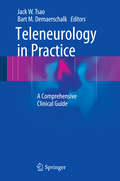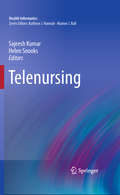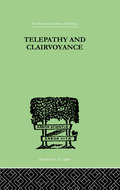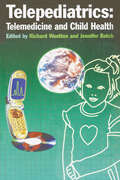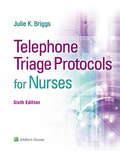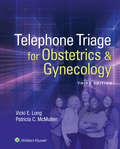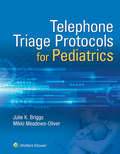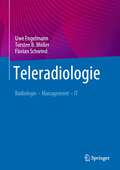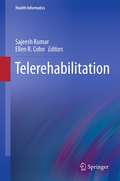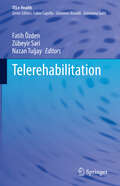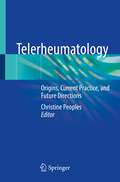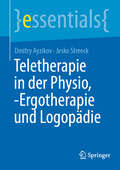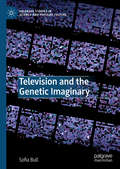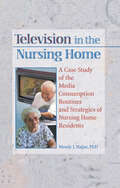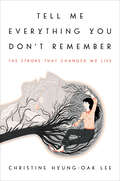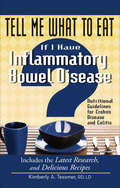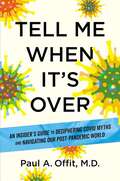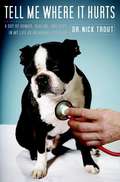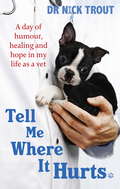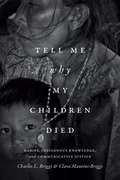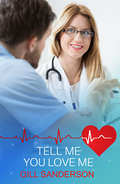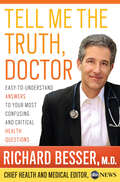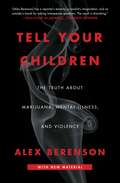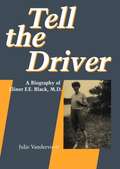- Table View
- List View
Teleneurology in Practice
by Jack W. Tsao Bart M. DemaerschalkThis title will provide an up-to-date review of the emerging practice of neurology telemedicine. Increasingly, neurology, like other disciplines of medicine, is implementing the technological advances and discoveries of the science of healthcare delivery to improve not only access and efficiency but outcomes and cost as well. For patients in remote and underserved areas, having a neurological condition means lengthy and costly travel to obtain specialist evaluation. Telemedicine has the ability to deliver such care to a patient's local community. Neurology telemedicine for acute stroke has already demonstrated clinical efficacy and cost effectiveness by raising the numbers of thrombolysis-eligible patients who can be treated in a timely fashion. More than 85% of leading US neurology departments currently use or plan to implement telemedicine within the next year. The US military has a limited number of neurologists - a store-and-forward consultation system has enabled military neurologists to deliver far-forward battlefield care for service members deployed overseas. The chapters in this book will review the use of telemedicine for the evaluation and treatment of patients with many common neurological conditions and will provide a practical guide for neurologists seeking to incorporate telemedicine into their daily practices.
Telenursing
by Helen Snooks Sajeesh KumarWritten by experts from around the globe (USA, Europe, Australia and Asia) this book explains technical issues, digital information processing and collective experiences from practitioners in different parts of the world practicing a wide range of telenursing applications including telenursing research by professionals in the field. This book lays the foundations for the globalisation of telenursing procedures, making it possible to know that a nursing service could perform on a patient anywhere in the world.
Telepathy and Clairvoyance (International Library Of Psychology Ser.)
by Tischner, RudolfFirst published in 1999. Routledge is an imprint of Taylor & Francis, an informa company.
Telepediatrics: Telemedicine and Child Health
by Amanda OakleyRecommended to all health professionals currently working or planning to set up services in paediatrics and telemedicine. This book is written by an international team of contributors who are working with paediatric telemedicine services. It covers a broad spectrum of topics:Specialist services: including Fetal medicine, Child psychiatry , Diabetes , Asthma, Burns, Paediatric surgery clinics, Sexual abuse, Tele-ophthalmology, Teleradiology and image transfer, Tele-ENTPrimary and community services: including Telemedicine and under-served communities (US and developing countries), Palliative care, Rehabilitation, Telephone help lines for parentsEducation services including: Education of doctors - Grand Rounds in Queensland, Australia, Educational videoconferences for parents in the Bronx, and websites for parents and children
Telephone Triage Protocols for Nurses
by Julie K. BriggsPerforming triage requires the ability to make quick, evidence-based decisions based on limited information. Nurses are often required to preform triage either over the phone, in urgent care settings, in the emergency department, and even in office settings. This reference provides over 200 triage protocols for evaluating a person’s symptoms. Each symptom entry lists pertinent questions grouped by urgency level and advises the clinician when and where the patient should be referred. This book is a need to have, comprehensive, user-friendly resource for every nurse who performs triage.
Telephone Triage for Obstetrics & Gynecology
by Vicki Long Patricia McMullenProvide top-level obstetrics and gynecology telephone triage that is safe, efficient, and effective, with Telephone Triage for Obstetrics & Gynecology, 3rd Edition. This at-your-fingertips guide offers a wide range of current, evidence-based protocols, backed by proven patient-questioning techniques, quick-reference charts, and real-life patient scenarios. Adaptable to private practice, hospital, clinic, or call center, this invaluable guide will help ensure that your telephone triage standards stay high, while your practice serves individual patient situations with empathy and accuracy, right from the start. Be expertly guided through the telephone triage rigors of data-gathering, protocols, and patient education, with these vital features: NEW chapter on incorporating internet research into advice on specific protoc NEW and expanded protocols that offer updated content on preconceptual screening, infectious disease impacts on pregnancy, infertility management, and emergency contraception Quick-reference sections that arrange protocols alphabetically for fast locating Easy-to-follow, data-gathering, flowchart format that helps you quickly determine the nature and urgency of the caller’s problem, and choose the appropriate intervention Easy-to-explain patient-education sections after each protocol Basic Triage Assessment Forms that address specific problems and require vital patient data Guidance on developing “telephone charisma” and the power of sympathetic listening Effective patient questioning techniques—pertinent questions to ask, types of questions, time management, getting clarification Real-life call scenarios that point out problems with not listening fully to the patient, skipping relevant questions, or exerting judgments Covers telephone triage basics, including logistical and legal considerations, assessments, telephone communication basics and challenges, and more Offers obstetric protocols, including overviews of preconceptual and infertility, early management of unintended pregnancy, fetal prenatal screening, early pregnancy evaluation and surveillance, and more Offers gynecologic protocols, including overviews of abnormal bleeding and spotting, amenorrhea, barrier contraceptives, breast complaints, emergency contraception, injectable contraceptives, intrauterine contraception, menopausal concerns, and more Vital guidance for all gynecologic nurses, obstetric nurses, certified nurse midwives, OB/GYN nurse practitioners, all triage nurses, and health professionals at call centers
Telephone Triage for Pediatrics
by Julie Briggs Mikki Meadows-OliverHandle questions about pediatric care with confident accuracy: Telephone Triage Protocols for Pediatrics is the quick-access guide to providing fast, efficient phone assessments and accurate care recommendations. This comprehensive, on-the-spot resource lists a broad range of symptoms alphabetically. A flow chart format provides the crucial Yes or No questions to ask, with each answer moving quickly to optimal recommendations or instructions. A vital resource for all nurses, this is irreplaceable to those in pediatric or family practice. Tap into top-level guidance for fast, efficient assessments … Step-by-step guidance for making accurate assessments—170 proven protocols addressing a wide range of symptoms, disorders, and medical emergencies, for newborn to age 18 Sorts life-threatening problems from those not requiring physician or emergency care—callers are directed to make an appointment, seek emergency care, or follow home care instructions Increases consistency of advice and documentation Supports nurses of all knowledge and experience levels Color tabs for each section enable quick access Symptoms alpha-organized and grouped by level of urgency, addressing injuries, trauma, pain, swelling, and other symptoms for: Head, eyes, ears, nose, throat, mouth, back, neck, arm, and leg Body system problems – chest/cardiovascular, respiratory GI, genital/obstetrics and gynecological problems, urination, and skin problems Chronic and infectious diseases Behavioral problems Infant-specific problems Sections under every symptom include: Key Questions to ask the caller Other Protocols to Consider Reminders – for proper documentation Assessment – symptoms and conditions that determine urgency Actioncolumn – Following Yes or No answers to assessment questions, with emergency actions appearing first Immediate actions – proven protocols and/or referrals to emergency, physician, or at-home care Home Care Instructions – before emergency care, before appointment, or at-home care Emergency Instructions – in-the-moment first aid Report the Following Problems – what caller should tell their physician or emergency department Seek Emergency Care Immediately – if certain symptoms occur
Teleradiologie: Radiologie – Management – IT
by Torsten B. Möller Uwe Engelmann Florian SchwindTeleradiologische Befundung wird immer wichtiger für Kliniken, die sich nachts und Feiertags keinen Radiologen leisten können oder wollen. Mit der immer populäreren Telemedizin ist auch die Teleradiologie seit Jahren immer mehr gewachsen.Ziel des Buches ist es, umfassend über das teleradiologische Arbeiten, die Möglichkeiten, Arbeitsabläufe, Infrastruktur und Anwendungsbereiche zu informieren. Dabei wird sowohl die Anwenderseite (der radiologische Arzt als Befunder) als auch die Auftraggeber-Seite (die Kliniken) beleuchtet, die hier eng verzahnt interagieren müssen. Inhalte:Das Buch informiert den Leser umfassend über die folgenden Aspekten der TeleradiologieÄrztliche AspekteSicht des Krankenhaus-Managements,gesetzliche Vorgaben (Strahlenschutzgesetz und -verordnung),DIN-Normen,Arbeitsabläufe,Genehmigungsprozess,Qualitätsaspekte,Integration in die IT-Landschaft der Beteiligten,Kommunikationsstandards in der Medizin/Radiologie,Beispiele realisierter Teleradiologie-Netzwerke,Datenschutz undRechtsfragen .
Telerehabilitation
by Sajeesh Kumar Ellen R. CohnWritten by experts from around the globe, this book presents explains technical issues and clinical applications. It includes collective experiences from rehabilitation service providers in different parts of the world practicing a wide range of telerehabilitation applications. This book lays the foundations for the globalization of telerehabilitation procedures, making it possible for rehabilitation service to be delivered anywhere in the world.
Telerehabilitation (TELe-Health)
by Fatih Özden Zübeyir Sari Nazan TuğayTelerehabilitation is becoming one of the most popular health service methods due to the recent advancements in information technology. The aim of this book is to present comprehensive telerehabilitation-based evaluation protocols and treatment modalities, offering evidence-based insights into their efficacy. Within the volume, various rehabilitation departments, including orthopedic, neurological, cardiopulmonary, geriatric, and pediatric rehabilitation, are explored in terms of telerehabilitation applications, practices, and assessment tools. The effectiveness of telerehabilitation methods, which are frequently used in clinical practice, is addressed also in terms of efficiency, cost-effectiveness, and ethics. In addition, international guidelines are pointed out comprehensively. This book will appeal not only to Physiotherapists and PM&R physicians but also to a broader audience of specialists interested in the field of telerehabilitation.
Telerheumatology: Origins, Current Practice, and Future Directions
by Christine PeoplesThis book details the practice of telerheumatology. Telemedicine is defined as the delivery of healthcare and the exchange of healthcare information across distances. Following, telerheumatology is the delivery of rheumatology care through telemedicine. There exists an increasing demand from patients, caregivers, and healthcare systems for access to academic specialists through telemedicine. This has been the case for the past several years and the demand has only increased with the ongoing COVID-19 pandemic. There is currently a lack of rheumatologists in rural areas and that is expected to spread to a general lack by 2025. Telerheumatology offers an excellent and timely solution to fill these gaps and provide care.Telerheumatology care has been shown to be feasible and quite effective. The current COVID-19 pandemic has thrust the concept of telemedicine into the spotlight. However, not all telerheumatology care is the same and there exists many nuances and differences when examining telerheumatology care across the United States and the world. After comprehensively reviewing the origins of telerheumatology, this work defines in detail the current practice of telerheumatology, along with the specific impact of the COVID-19 pandemic and all applications of telerheumatology. Expert authors also provide a detailed roadmap for providers to initiate, sustain, and grow a telerheumatology program. The book concludes by covering future directions of telerheumatology, including areas for expansion, improvement, and innovation.After reading this work, the editor and all the contributing authors hope that it will inspire, provoke thought and discussion, and lead to increased adaptation of providing telerheumatology care by rheumatologists and rheumatology providers.
Teletherapie in der Physio, -Ergotherapie und Logopädie (essentials)
by Jesko Streeck Dmitry AyzikovDas essential bietet einen Leitfaden für Physiotherapeut*innen, Ergotherapeut*innen und Logopäd*innen, um mit Hilfe der Teletherapie eine qualitativ hochwertige Versorgung ermöglichen zu können. Erfahren Sie alles über die Vorteile und die praktische Umsetzung einer Behandlung auf Distanz. Mit klar strukturierten Anleitungen und praxisnahen Beispielen können Sie teletherapeutische Interventionen mühelos umsetzen. Wertvolle Tipps und konkrete Fallbeispiele machen dieses Buch zu einem unverzichtbaren Begleiter. Zudem werden theoretische Grundlagen verständlich erklärt, um Ihr Wissen über die Vorteile der Teletherapie zu vertiefen. Aus dem Inhalt: Neugestaltung der Therapie durch Telemedizin, Entscheidungsfindung zur Eignung eines Patienten für Teletherapie, was ist Teletherapie und welche Faktoren beeinflussen eine Behandlung?, Die Rolle der Therapeut*in im Genesungsprozess der Patient*innen, Onlinediagnostik und Differentialdiagnostik, Tipps und Tricks für die Gestaltung einer Teletherapeutischer Sitzung und ein Praxisbeispiel einer Behandlung auf Distanz.
Television and the Genetic Imaginary (Palgrave Studies in Science and Popular Culture)
by Sofia BullThis book examines the complex ways in which television articulates ideas about DNA in the early 21st century. Considering television’s distinct aesthetic and narrative forms, as well as its specific cultural roles, it identifies TV as a key site for the genetic imaginary. The book addresses the key themes of complexity and kinship, which function as nodes around which older essentialist notions about the human genome clash with newly emergent post-genomic sensibilities. Analysing a wide range of US and UK programmes, from science documentaries, science fiction serials and crime procedurals, to family history programmes, sitcoms and reality shows, Television and the Genetic Imaginary illustrates the extent to which molecular frameworks of understanding now permeate popular culture.
Television in the Nursing Home: A Case Study of the Media Consumption Routines and Strategies of Nursing Home Residents
by Wendy J HajjarTelevision in the Nursing Home: A Case Study of the Media Consumption Routines and Strategies of Nursing Home Residents is a three-stage ethnographic study of media use by the elderly in long-term care facilities. This research concludes that watching television is the most prevalent and pervasive activity for patients. Activity directors can now learn how television and media can offer diversion, enhancement of personality, awareness, and sociability to their patients and offers suggestions on roommate coordination, selection of appropriate media, and communication resources. Containing the latest knowledge involving communication and gerontology, Television in the Nursing Home will help you offer programs that will meet the demands of an expanding elderly population.Developed as a perspective for examining patterns of social interaction, Television in the Nursing Home gives suggestions on how you can use the media to create new activities for patients, maximizing the television as a resource for the elderly. You will gain valuable insight on: proof to dispel the myth that television in long-term patient care causes withdrawal and depression a breakthrough in the treatment of media and aging, enhancing media-based activities and the use and purchase of electronic equipment for care facilities studies on how and why television is the most accessible medium of communication information for the development of new media designed specifically for use by the elderly creation of media-centered activities that recognize the potential for therapeutic use of communication technologies in the nursing homeThe research presented in Television in the Nursing Home establishes the fact that television consumption, once thought to be problematic, should be seen as desirable and necessary. This important book also proves how television is a resource that provides comfort, self-expression, and sociality. This first-ever study will convince you that television and media use in long-term care is beneficial and essential to the wellness of your patients.
Tell Me Everything You Don't Remember: The Stroke That Changed My Life
by Christine Hyung-Oak LeeA memoir of reinvention after a stroke at age thirty-three.Christine Hyung-Oak Lee woke up with a headache on the morning of December 31, 2006. By that afternoon, she saw the world—quite literally—upside down. By New Year’s Day, she was unable to form a coherent sentence. And after hours in the ER, days in the hospital, and multiple questions and tests, her doctors informed her that she had had a stroke. For months afterward, Lee outsourced her memories to a journal, taking diligent notes to compensate for the thoughts she could no longer hold on to. It is from these notes that she has constructed this frank and compelling memoir.In a precise and captivating narrative, Lee navigates fearlessly between chronologies, weaving her childhood humiliations and joys together with the story of the early days of her marriage; and then later, in painstaking, painful, and unflinching detail, the account of her stroke and every upset—temporary or permanent—that it caused. Lee illuminates the connection between memory and identity in an honest, meditative, and truly funny manner, utterly devoid of self-pity. And as she recovers, she begins to realize that this unexpected and devastating event has provided a catalyst for coming to terms with her true self—and, in a way, has allowed her to become the person she’s always wanted to be.
Tell Me What to Eat If I Have Inflammatory Bowel Disease: Nutritional Guidelines for Crohn's Disease and Colitis (Tell Me What to Eat)
by Kimberly A. TessmerIBD isn’t a disease but rather the umbrella term for two major intestinal disorders that might sound more familiar: ulcerative colitis and Crohn’s disease. Both deal with inflammation in the digestive tract that can produce a wide range of unpleasant symptoms and lead to other health conditions.If you or a loved one are dealing with either of these conditions then you probably know that trying to control flare-ups—which bring on the symptoms—is the goal. Tessmer breaks down both of these conditions and provides reliable and practical advice on how eating right can help.Tell Me What to Eat If I Have Inflammatory Bowel Disease begins with an overview of both of these conditions (as well as Irritable Bowel Syndrome, or IBS), then guides you through diet recommendations that are based on the latest medical information.You will quickly learn what IBD is and what you can do to limit the impact of unwanted symptoms. In addition, you’ll get dozens of mouthwatering recipes from knowledgeable RDs that will make implementing the nutritional advice a bit easier.It’s all nutrition you can live with!
Tell Me When It's Over: An Insider's Guide To Deciphering Covid Myths And Navigating Our Post-pandemic World
by Paul A. OffitFrom one of the world’s top virologists, the definitive guide to understanding—and navigating—COVID-19. Three years on, COVID is clearly here to stay. So what do we do now? Drawing on his expertise as one of the world’s top virologists, Dr. Paul Offit helps weary readers address that crucial question in this brief, definitive guide. As a member of the FDA Vaccine Advisory Committee and a former member of the Advisory Committee for Immunization Practices to the CDC, Offit has been in the room for the creation of policies that have affected hundreds of millions of people.In these pages, he marshals the power of hindsight to offer a fascinating frontline look at where we were, where we are, and where we’re heading in the now-permanent fight against the disease. Accompanied by a companion website populated with breaking news and relevant commentary, this book contains everything you need to know to navigate COVID going forward. Offit addresses fundamental issues like boosters, immunity induced by natural infection, and what it means to be fully vaccinated. He explores the dueling origin stories of the disease, tracing today’s strident anti-vax rhetoric to twelve online sources and tracking the fallout. He breaks down long COVID—what it is, and what the known treatments are. And he looks to the future, revealing whether we can make a better vaccine, whether it should be mandated, and providing a crucial list of fourteen takeaways to eradicate further spread. Filled with pragmatic analysis and sensible advice, TELL ME WHEN IT’S OVER is for anyone interested in finding new solutions to the new normal.
Tell Me Where It Hurts: A Day of Humor, Healing, and Hope in My Life as an Animal Surgeon
by Nick TroutFrom the Book Jacket: It's 2:47 A.M., when Dr. Nick Trout takes the phone call that starts another hectic day at the Angell Animal Medical Center. Sage, a ten-year-old German shepherd, will die without emergency surgery for a serious stomach condition. Over the next twenty-four hours Dr. Trout fights for Sage's life, battles disease in the operating room, unravels tricky diagnoses, reassures frantic pet parents, and reflects on the humor, heartache, and inspiration in his life as an animal surgeon. And he wants to take you along for the ride... On the front lines of modern medicine, Tell Me Where It Hurts is a fascinating insider portrait of a veterinarian, his furry patients, and the blend of old-fashioned instincts and cutting-edge technology that defines pet care in the twenty-first century. For anyone who's ever wondered what goes on behind the scenes at your veterinarian's office, Tell Me Where It Hurts offers a vicarious journey through twenty-four intimate, eye-opening, heartrending hours at the preeminent Angell Animal Medical Center in Boston. You'll learn about the amazing progress of modern animal medicine, where organ transplants, joint replacements, and state-of-the-art cancer treatments have become more and more common. With these technological advances come controversies and complexities that Dr. Trout thoughtfully explores, such as how long (and at what cost) treatments should be given, how the Internet has changed pet care, and the rise in cosmetic surgery. You'll also be inspired by the heartwarming stories (continued on back flap) (continued from front flap) of struggle and survival filling these pages. With a wry and winning tone, Dr. Trout offers up hilarious and delightful anecdotes about cuddly (or not-so-cuddly) pets and their variously zany, desperate, and demanding owners. In total, Tell Me Where It Hurts offers a fascinating portrait of the comedy and drama, complexities and rewards involved with loving and healing animals. Part ER, part Dog Whisperer, and part House, this heartfelt and candid book shows that while the technology has changed since James Herriot's day, the humanity and compassion remain unchanged. If you've ever had a pet or special place in your heart for furry friends, Dr. Trout's irresistible book is for you. Nick Trout is a staff surgeon at the Angell Animal Medical Center and lives near Boston, Massachusetts.
Tell Me Where It Hurts: A Day of Humour, Healing and Hope in My Life as a Vet
by Dr Nick TroutIt's 2:47am when Dr Nick Trout, a British vet working in Boston, USA, is abruptly woken and called in to the Angell Memorial Animal Hospital to see if he can save the life of Sage, a ten year-old German Shephard with a critical stomach condition. The case is severe, the outlook bleak, and Dr Trout is her only chance. So begins an intimate and exhilarating journey into a typical day in a far from typical job.TELL ME WHERE IT HURTS takes the reader to the heart of the trials and tribulations of life as a veterinary surgeon, a life filled with heartbreak, triumph, anxiety, and of course, cuddly pets and their variously crazy, desperate, and demanding owners. The day's events come alive with Trout's breezy and companionable narration, and while he illustrates many of the issues pertinent to 21st century pet medicine, at its heart, the book reminds us that while the technology may have moved on from James Herriot's day, the essential characters, humour, and humanity remain the same as ever.
Tell Me Why My Children Died: Rabies, Indigenous Knowledge, and Communicative Justice
by Charles L. Briggs Clara Mantini-BriggsTell Me Why My Children Died tells the gripping story of indigenous leaders' efforts to identify a strange disease that killed thirty-two children and six young adults in a Venezuelan rain forest between 2007 and 2008. In this pathbreaking book, Charles L. Briggs and Clara Mantini-Briggs relay the nightmarish and difficult experiences of doctors, patients, parents, local leaders, healers, and epidemiologists; detail how journalists first created a smoke screen, then projected the epidemic worldwide; discuss the Chávez government's hesitant and sometimes ambivalent reactions; and narrate the eventual diagnosis of bat-transmitted rabies. The book provides a new framework for analyzing how the uneven distribution of rights to produce and circulate knowledge about health are wedded at the hip with health inequities. By recounting residents' quest to learn why their children died and documenting their creative approaches to democratizing health, the authors open up new ways to address some of global health's most intractable problems.
Tell Me You Love Me: A Thrilling Medical Romance (Medical Romances #15)
by Gill SandersonAnother captivating medical romance from best-selling author Gill Sanderson! Perfect for fans of Mia Faye, Laura Scott, Helen Scott Taylor, Grey's Anatomy and ER.Readers ADORE Gill's gripping medical romances!'A truly gifted writer with an enormous amount of talent and sensitivity' 5* author review'This book has all it takes... romance, thrills, high adventure...' 5* reader review '... it's a joy to lose yourself in such an interesting book' 5* reader reviewAbbey Fraser was the new doctor in charge of a team of divers working off the Scottish coast. It was fascinating work, at times dangerous. Perhaps more dangerous was her relationship with John Cameron, the Dive Master. She was attracted to the man and knew he was attracted to her. How could there be a future for them? John was a dedicated wanderer.Then came the most horrific coincidence possible. She discovered it was possible that John had been responsible for the underwater death of her husband! There would be more danger in a storm at sea before the two of them managed to sort out their problems.Don't miss Gill Sanderson's enthralling medical romances, including the A Lakeland Practice and the Good, Bad and Ugly series.
Tell Me You Love Me: A Thrilling Medical Romance (Medical Romances Ser.)
by Gill SandersonAnother captivating medical romance from best-selling author Gill Sanderson! Perfect for fans of Mia Faye, Laura Scott, Helen Scott Taylor, Grey's Anatomy and ER.Readers ADORE Gill's gripping medical romances!'A truly gifted writer with an enormous amount of talent and sensitivity' 5* author review'This book has all it takes... romance, thrills, high adventure...' 5* reader review '... it's a joy to lose yourself in such an interesting book' 5* reader reviewAbbey Fraser was the new doctor in charge of a team of divers working off the Scottish coast. It was fascinating work, at times dangerous. Perhaps more dangerous was her relationship with John Cameron, the Dive Master. She was attracted to the man and knew he was attracted to her. How could there be a future for them? John was a dedicated wanderer.Then came the most horrific coincidence possible. She discovered it was possible that John had been responsible for the underwater death of her husband! There would be more danger in a storm at sea before the two of them managed to sort out their problems.Don't miss Gill Sanderson's enthralling medical romances, including the A Lakeland Practice and the Good, Bad and Ugly series.
Tell Me the Truth, Doctor: Easy-to-Understand Answers to Your Most Confusing and Critical Health Questions
by Richard Besser"Hey, Doc--Got a Minute?"No matter where Dr. Richard Besser goes, a day doesn't go by without someone stopping him to ask that question. Often, that person is one of the millions who have come to rely on the vital information he shares on Good Morning America, World News with Diane Sawyer, and Nightline. Now, in response to thousands of inquiries from viewers, Dr. Besser has written his first book--a comprehensive health guide that will both inform and surprise as he deciphers fact from fiction for nearly seventy confusing medical questions, including:- "Should I take a daily aspirin to prevent a heart attack, stroke, or cancer?"- "If my doctors order a lot of tests, does that mean they're more thorough?" - "Do I need thirty minutes of exercise a day to stay healthy?"Recognizing the astonishing amount of misinformation that many important health decisions are based upon, Dr. Besser's commitment to delivering the truth is critical. He isn't afraid to challenge the status quo--or the interests within the health care industry--to provide the knowledge you need to take control of your health. Eager to help you make the choices that are right for YOU, he organizes his easy-to-understand answers into six lifestyle categories, including diet and nutrition; exercise and fitness; vitamins, supplements, and medicines; beating illness and injury; and navigating the perplexing world of health care, as well as a chapter dedicated to the questions you wished you asked before your doctor walks out the door.Throughout the book, Dr. Besser smashes myths while translating invaluable information into problem-solving advice you can use, including a "Dr. B's Bottom Line" at the end of each topic. As accessible as it is empowering, Dr. Besser's Tell Me the Truth, Doctor is a necessary addition to every home, office, and dorm room. "Besser . . . ably analyzes popular myths (the "Freshman Fifteen"), considers pros and cons (HRT and statins), and mostly takes unequivocal stands on the issues. . . . Quite often, his comments and suggestions surprise. . . . Particularly helpful are his guidelines for avoiding the harmful effects of health care and hospitalization." --Publishers Weekly Richard Besser, MD, ABC News' Chief Health and Medical Editor, provides medical analysis and commentary for all ABC News broadcasts and platforms, including World News with Diane Sawyer, Good Morning America, and Nightline, as well as many other news/entertainment programs. me he led the CDC's response to the H1N1 influenza outbreak. He has taught and trained doctors at the University of California, San Diego and is a visiting fellow at the Harvard School of Public Health. Most important, for more than twenty-five years he has practiced medicine, giving his patients and their families straightforward, commonsense advice.
Tell Your Children: The Truth About Marijuana, Mental Illness, and Violence
by Alex BerensonAn eye-opening report from an award-winning author and former New York Times reporter reveals the link between teenage marijuana use and mental illness, and a hidden epidemic of violence caused by the drug—facts the media have ignored as the United States rushes to legalize cannabis.Recreational marijuana is now legal in nine states. Almost all Americans believe the drug should be legal for medical use. Advocates argue cannabis can help everyone from veterans to cancer sufferers. But legalization has been built on myths– that marijuana arrests fill prisons; that most doctors want to use cannabis as medicine; that it can somehow stem the opiate epidemic; that it is not just harmless but beneficial for mental health. In this meticulously reported book, Alex Berenson, a former New York Times reporter, explodes those myths: • Almost no one is in prison for marijuana; • A tiny fraction of doctors write most authorizations for medical marijuana, mostly for people who have already used; • Marijuana use is linked to opiate and cocaine use. Since 2008, the US and Canada have seen soaring marijuana use and an opiate epidemic. Britain has falling marijuana use and no epidemic; • Most of all, THC—the chemical in marijuana responsible for the drug’s high—can cause psychotic episodes. After decades of studies, scientists no longer seriously debate if marijuana causes psychosis. Psychosis brings violence, and cannabis-linked violence is spreading. In the four states that first legalized, murders have risen 25 percent since legalization, even more than the recent national increase. In Uruguay, which allowed retail sales in July 2017, murders have soared this year. Berenson’s reporting ranges from the London institute that is home to the scientists who helped prove the cannabis-psychosis link to the Colorado prison where a man now serves a thirty-year sentence after eating a THC-laced candy bar and killing his wife. He sticks to the facts, and they are devastating. With the US already gripped by one drug epidemic, this book will make readers reconsider if marijuana use is worth the risk.
Tell the Driver: A Biography of Elinor F.E. Black, MD
by Julie VandervoortA biography of Dr. Elinor Black (1905-1982), the first Canadian woman to gain membership in the Royal College of Obstetricians and Gynecologists in London.
